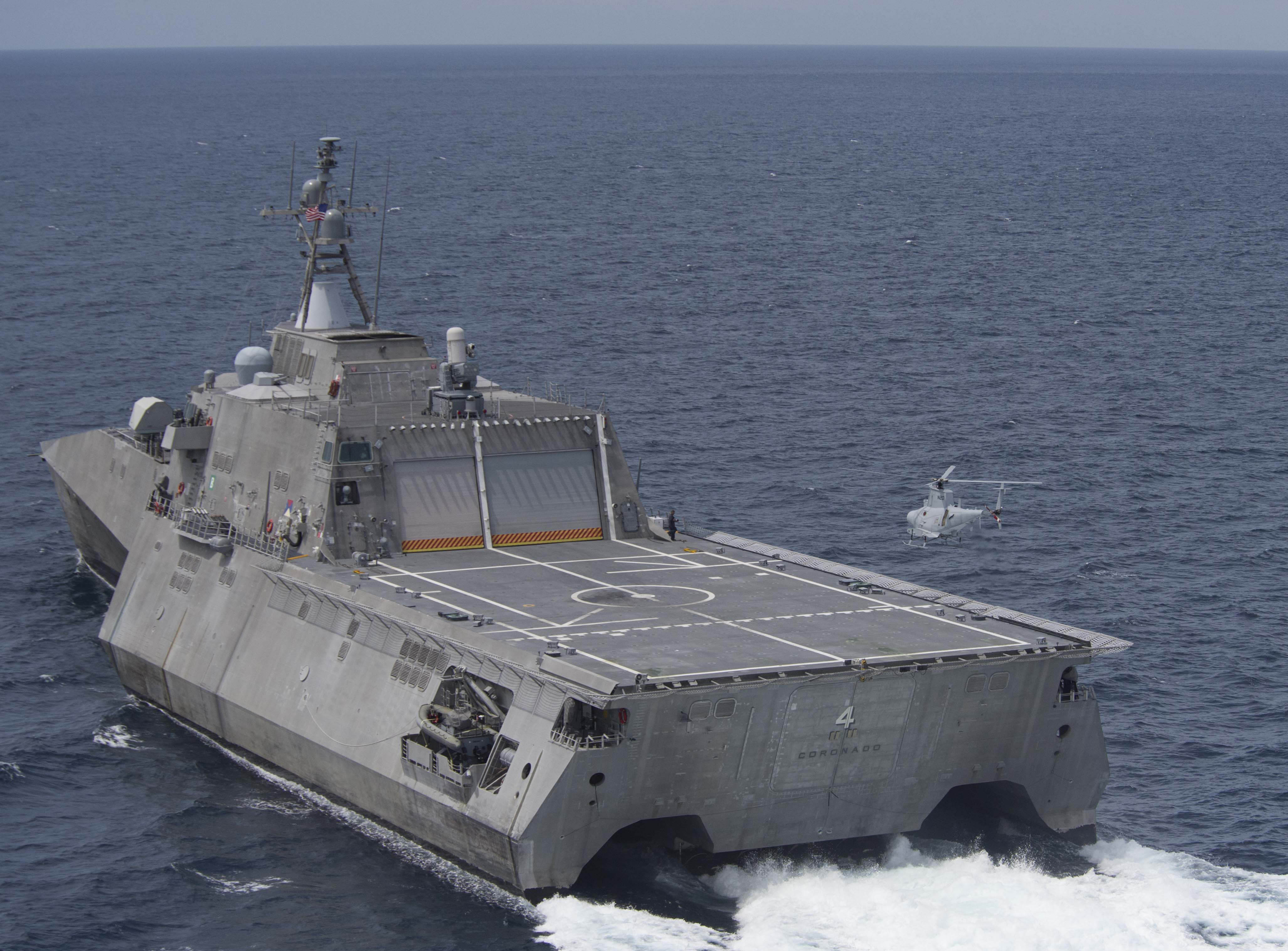
WASHINGTON NAVY YARD – The unmanned systems portfolio within the Program Executive Office for Littoral Combat Ship is maturing as the Navy’s future plans are increasingly emphasizing these vehicles, putting the PEO in an important position to shape how the service incorporates these emerging technologies into future operations, PEO LCS Rear Adm. John Neagley told USNI News.
The shipbuilding side of the PEO’s portfolio may be shifting away from LCS and towards the upcoming frigate class, but Neagley said the unmanned systems portfolio is exciting and full of promise, and that it will help the LCS and the rest of the Navy fleet remain relevant warfighting assets.
In his first formal interview since taking over the PEO a year ago, Neagley said that Navy strategies and plans point to an increasing reliance on unmanned vehicles in all domains going forward, which bodes well for his PEO.
“The LCS was built from the ground up really to launch and recover unmanned vehicles, so in terms of the communications that are required to go talk to those things, it’s all baked into the software as part of the mission package computing environment, to be able to launch and recover those things, the stern ramps and the twin boom extensible crane, that’s what they’re there for,” the admiral said.
“So that’s the great synergy. But those systems aren’t limited to LCS. You could deploy them off a number of other systems if you wanted. So it’s pretty exciting. When you look at some of the larger studies we’ve done, the fleet architecture study, certainly unmanned has a big piece of that, and to be on the front end of that has been good for us.”

Neagley said relying on unmanned systems for mission capability is the ultimate modular design – instead of the LCS sitting in a long-term and expensive pier-side maintenance availability, “you can bring that combat capability real-time if you’re meeting [specifications in the interface control document]. You just have a new piece of equipment, whether it’s a UUV, USV, UAV, whatever it is; you know what the interface requirements are on the ship; you can do all that development out away from the ship and bring it real time, and then the ship doesn’t get tied up and it’s cheaper in the long run, and it allows you to iterate faster.”
Chief of Naval Operations Adm. John Richardson told reporters recently that he saw LCS as a “prototype” for future modular designs and that the future Navy would center around this modular and adaptable design for delivering combat power.
In discussing the modular LCS’s ability to evolve to meet fleet needs, Neagley noted it was designed for three main missions – anti-surface warfare, mine countermeasures and anti-submarine warfare – but that the PEO and the fleet have found other ways to leverage the ship.
No new formal “mission packages” have been created yet, but “we have shown the modularity of the ship, the ability to take stuff on the ship. I don’t call it a mission package, but … we’ve done some work with the [explosive ordnance disposal] crew doing expeditionary [mine countermeasures]; we’ve done a number of exercises with them where they’ve brought their whole kit onboard with their UUVs and their combat raiding craft, those kinds of things. So I think we’ll see more of that, really leveraging the modularity of the ship to bring new things out, get them out early to the fleet, let the fleet play with that, learn from them quickly. This is all about learning quickly: get it into the hands of sailors, and some of that stuff will gel and we may call it a mission package; some of it will just, hey, here’s a new capability we can bring. We’re a good platform for doing that kind of work.”
As for the original three mission packages, Neagley said the unmanned systems that reside within those mission packages are proceeding well through testing.
On the mine countermeasures package, the Airborne Laser Mine Detection System and the Airborne Mine Neutralization System reached initial operational capability last year to operate in blue water. The Coastal Battlefield Reconnaissance and Analysis (COBRA) for beach zone detection is undergoing initial operational test and evaluation now at Wallops Island, Va., and should reach IOC later this year, Neagley said.
Additionally, the Common Unmanned Surface Vehicle is undergoing testing at the South Florida Test Range now, deploying and retrieving the unmanned influence sweep system for mine sweeping missions. The CUSV has also been selected to serve some mine hunting missions and will begin testing in Florida next year with a towed sonar system, Neagley said.

For the surface warfare mission package, an early increment of which is already being used in LCS operations out of Singapore, more milestones are on the horizon. Technical evaluation and initial operational test and evaluation for the new surface-to-surface mission module – centered around a ship-launched Longbow Hellfire anti-ship missile – is set for 2018 on the Freedom-variant LCSs, according to Neagley. The Navy has already done structural tests in February from USS Detroit (LCS-7), and the PEO fired the weapon from a surrogate vessel. Formal developmental tests will begin this July from USS Milwaukee (LCS-5), demonstrating full integration of the weapon onto the LCS ahead of next year’s evaluation.
The anti-submarine escort mission module contract was awarded to Raytheon this spring, will begin testing in 2018, and should reach IOC in 2019. Outside of this escort mission module, a light-weight tow torpedo decoy will be installed on all LCSs outside of the mission package construct. Early decoy testing will begin this summer or fall, with formal testing taking place alongside the mission package testing in 2019. The whole ASW mission package should reach IOC by the end of Fiscal Year 2019.





